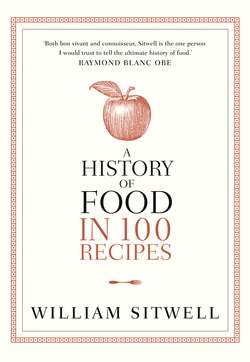Читать книгу A History of Food in 100 Recipes - William Sitwell - Страница 20
Оглавление13
Rummaniyya
(Meatballs in pomegranate sauce)
1250
AUTHOR: Unknown,
FROM: Kanz al-fawa’id fi tanwi al-mawa’id (The Treasure of Useful Advice for the Composition of a Varied Table)
Cut the meat into pieces, put in a pot and cover with water. Bring to a boil while removing the fetid scum. Next add small meatballs the size of a hazelnut. The quantity of broth must be reduced so that when the cooking is done only a residue of light and velvety juice remains. In the meantime, take some sour pomegranate juice, sweeten it with rose water syrup, add some mint and pistachios crushed in the mortar to thicken it, colour it with a little saffron and season with all [the ingredients] of atraf tib [a mixture of spices including black pepper, cloves and ginger]. Sprinkle with rose water and diluted saffron and serve.
Hungry young mouths across thirteenth-century Egypt must have been growing tired of being filled with meatballs. These were pretty much a staple food. So a book circulating in 1250 called Kanz al-fawa’id fi tanwi al-mawa’id (or ‘The Treasure of Useful Advice for the Composition of a Varied Table’) – written at the time when the Mamluk warriors, who were descended from slaves, ruled Egypt – must have felt like the first specks of rain after a long, dry desert of a summer.
Its recipes reflect the influences brought about by immigration caused by conflict around the Middle East. New eating habits and dishes came from far and wide, from Greece (turnips, Greek style), for example, Baghdad (a condensed yoghurt called qanbaris) and the Frankish region of Germany (a salsa for fish). The Crusades in Syria and Palestine, the Mogul invasion of Iraq, not to mention other conflicts, saw armies and their entourages importing and exporting food as they came and went. Returning to Europe, the battle-weary men didn’t just bring tales of extraordinary adventures in far-flung places, they had a taste of them in their luggage.
The exotic ingredients they brought back with them, such as rose water and pomegranate, then influenced European cookery for generations to come. Indeed rose water became almost ubiquitous in dishes served at English banquets. Sweet was continually mixed with savoury, to the extent that it then took many centuries for sweet dishes to get a final course of their own.
Rummaniyya (which translates as ‘dish with pomegranate’) is a classic example of this: meatballs with the addition of tangy pomegranate juice. The inclusion of exotic ingredients to enliven humdrum foodstuffs would have wowed medieval banqueters back in England at the time Kanz was circulating. Other dishes include carrot jam (a sort of a chutney), quince cordial and a recipe for hummus incorporating pickled lemons, cinnamon, ginger, parsley, mint and rue – although as rue is almost toxic, substituting it with rosemary would be a safer bet.
The book also includes plenty of references to the health benefits of particular foods, derived from contemporary or earlier dietetic texts. Cookbooks in Europe followed suit for the next few hundred years, listing recipes because they were thought to be medicinal rather than because they tasted good. Although many of the ingredients they included, pomegranate among them, remain renowned for their health properties to this day.
But this dish would have needed a little care in the preparation as there is a distinct lack of oil and neither is there salt. It might have been medicinal, but it didn’t need to taste like medicine. So the trick for the cook would have been to successfully balance the sour and sweet flavours. Which someone must have been doing in Europe as this style of cooking caught on. The likes of lamb stew served with fresh apricots, beef cooked with pistachios, chicken with walnuts or the vegetarian dish of fava beans in a sour sauce with hazelnuts, were seen as rich and exotic and soon mixing sweet and sour became the signature combination of the medieval meal.
